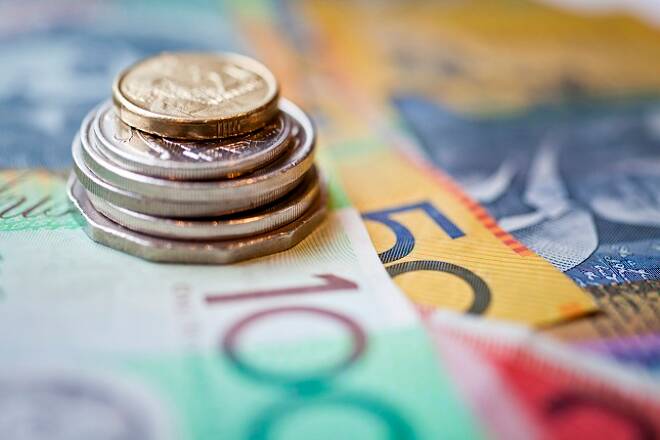Advertisement
Advertisement
AUD/USD and NZD/USD Fundamental Weekly Forecast – Heightened Volatility, Early Strength Due to Surprise Aussie Election Results
By:
Over the short-run, the AUD/USD could get a boost from the election results, but gains are likely to be limited and prices could fall further because of the weakening economy and the expected rate cut.
The Australian and New Zealand Dollars took big hits last week as bearish traders increased their bets for a rate cut by the Reserve Bank of Australia (RBA) and the Reserve Bank of New Zealand. The catalyst for most of the selling pressure was a rise in the Australian unemployment rate. Strengthening U.S. economic data and increased concerns over U.S.-China trade relations also pressured the Aussie and the Kiwi.
Last week, the AUD/USD settled at .6868, down 0.0131 or -1.87% and the NZD/USD finished at .6514, down 0.0085 or -1.29%.
Australian Dollar
Last week’s trade centered on the Australian labor market. The Wage Price Index came in at 0.5%, falling below the 0.6% forecast. The Employment Change showed the economy added 28.4K in April, well above the 15.2K estimate. The prior month was revised higher to 27.7K. The Unemployment Rate rose to 5.2%, up from the upwardly revised 5.1%. Traders were looking for a reading of 5.0%.
Although the economy added more jobs than expected, the AUD/USD plunged last month because part-time jobs represented most of the gains while full-time jobs fell. Furthermore, the unemployment rate rose to its highest level in eight months. This data cemented views the RBA may be forced to lower rates soon to stimulate the economy.
In other news, Australian Home Loans fell 2.5 percent, well below the forecast for a 2.2% increase. The prior month was also revised lower to 1.4%. This report indicates that the weakening economy is having a negative effect on Australian housing demand.
Westpac Consumer Sentiment also fell from 1.9% to 0.6%, indicating consumers are turning soft on the economy.
There were no major reports out of New Zealand last week, but Producer Inflation Input and Output came in well-below the forecasts.
Positive reports from the U.S. and steady tone by most Fed speakers also weighed on the Aussie and Kiwi. In the U.S. the key positive developments were a jump in the Empire State Manufacturing Index from 10.1 to 17.8, a surge in the Philly Fed Manufacturing Index from 8.5 to 16.6 and better-than-expected Housing Starts data. Weekly Unemployment Claims also showed a strengthening jobs market, coming in at 212K, lower than the 220K forecast.
The biggest drag on the Aussie and Kiwi was the unexpected rise in consumer sentiment. According to the University of Michigan, consumer sentiment jumped to 102.4, soundly beating the 97.8 forecast. This helped reduce the chances of a U.S. recession and a rate cut by the Fed.
Weekly Forecast
Over the week-end, Australia’s Prime Minister Scott Morrison, swept his Conservative-Liberal coalition to victory. He also vowed to get straight back to work after a shock win saw him re-elected for three more years. According to Bloomberg, “The Australian Dollar is set to strengthen against the greenback after the nation’s center-right government clung to power in a surprise election victory at the weekend.”
The news is potentially bullish because it takes the Labor Party’s tax proposals off the table. This should give some relief to the housing market. Furthermore, with the incumbent government being viewed as stronger economic managers, business sentiment is expected to improve, according to Andrew Ticehurst, Sydney-based rate strategist at Nomura Holding Inc. “It’s a net positive for the equity market and the Australian Dollar will likely bounce,” he added.
Mid to Longer-Term Outlook
Over the short-run, the AUD/USD could get a boost from the election results, but gains are likely to be limited and prices could fall further because of the weakening economy and the expected rate cut. But let’s assume that a rate cut has been nearly priced into the market. Traders just aren’t sure if it will come in June, July or August.
In its recent monetary policy statements, the RBA has said that a lack of improvement in the labor market would warrant a rate cut, so last week’s data is likely to be of great concern to them. Traders are now placing a 50/50 chance of a cut in June.
The data has “increased the risk the Reserve Bank of Australia (RBA) will cut the cash rate in June, earlier than our call of July,” said Kaixin Owyong, Sydney-based economist at National Australia Bank.
In other news, investors will be keeping an eye on U.S.-China trade relations, which apparently came to a standstill on Friday, according reports. Reports said the two economic powerhouses basically shut down trade talks after the U.S. basically hit Hauwei with new sanctions.
With the election results added to the equation, traders should look for volatility and a two-sided trade. The news isn’t likely to sway the RBA from raising rates, but it does bring hope to the economy, according to the election results.
About the Author
James Hyerczykauthor
James is a Florida-based technical analyst, market researcher, educator and trader with 35+ years of experience. He is an expert in the area of patterns, price and time analysis as it applies to futures, Forex, and stocks.
Latest news and analysis
Advertisement
